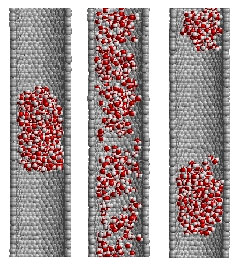Carbon Nanotubes in Water:
MD Simulations of External & Internal Flow, Self Organization
aInstitute of Computational Sciences ICOS ETH Zurich,
Zurich CH-8092 SWITZERLAND
bNASA Ames Research Center
This is an abstract
for a presentation given at the
Ninth
Foresight Conference on Molecular Nanotechnology.
There will be a link from here to the full article when it is
available on the web.
We have developed computational tools, based on particle codes, for molecular dynamics (MD) simulation of carbon nanotubes (CNT) in aqueous environments. The interaction of CNTs with water is envisioned as a prototype for the design of engineering nano-devices, such as artificial sterocillia and molecular biosensors. Large scale simulations involving thousands of water molecules are possible due to our efficient parallel MD code that takes long range electrostatic interactions into account.
Since CNTs can be considered as rolled up sheets of graphite, we expect the CNT-water interaction to be similar to the interaction of graphite with water. However, there are fundamental differences between considering graphite and CNTs, since the curvature of CNTs affects their chemical activity and also since capillary effects play an important role for both dynamic and static behaviour of materials inside CNTs [1,2]. In recent studies Gordillo and Marti [3,4] described the hydrogen bond structure as well as time dependent properties of water confined in CNTs.
We are presenting results from the development of force fields describing the interaction of CNTs and water based on ab-initio quantum mechanical calculations. Furthermore, our results include both water flows external to CNTs and the behaviour of water nanodroplets inside heated CNTs. In the first case (external flows) the hydrophobic behaviour of CNTs is quantified and we analyze structural properties of water in the vicinity of CNTs with diagnostics such as hydrogen bond distribution, water dipole orientation and radial distribution functions [1]. The presence of water leads to attractive forces between CNTs as a result of their hydrophobicity. Through extensive simulations we quantify these attractive forces in terms of the number and separation of the CNT. Results of our simulations involving arrays of CNTs indicate that these exhibit a hydrophobic behaviour that leads to self-organising structures capable of trapping water clusters. In the second case (internal flows) we study the behaviour of water droplets confined inside CNTs. Constant temperature simulations allow us to capture structural properties such as the contact angles and density profiles of the equilibrated drops [2]. By heating and subsequently cooling of the CNT, cf. Figure 1, we are able to measure the evaporation and the condensation rate of the entrapped water.

Figure: Three snapshots of a droplet during an evaporation - condensation cycle.
References
- J.H. Walther et al. Carbon nanotubes in water: Structural characteristics and energetics. J. Phys. Chem. B, submitted.
- T. Werder et al. Equilibrium Structure, Evaporation and Condensation of Water Droplets in Carbon Nanotubes. J. Heat Trans., 2001, submitted
- M.C. Gordillo et al. Hydrogen bond structure of liquid water confined in nanotubes. Chem. Phys. Lett., 329:341-345, 2000.
- J. Marti et al. Time-dependent properties of liquid water isotopes adsorbed in carbon nanotubes. J. Chem. Phys.114(23):10486-10492
Abstract in RTF format 434,517 bytes
*Corresponding Address:
Petros Koumoutsakos
Institute of Computational Sciences ICOS ETH Zurich
Weinbergstrasse 43, Zurich CH-8092 SWITZERLAND
phone: +41 1 632 6814
fax: +41 1 632 1703
email: [email protected]
http://www.icos.ethz.ch
|